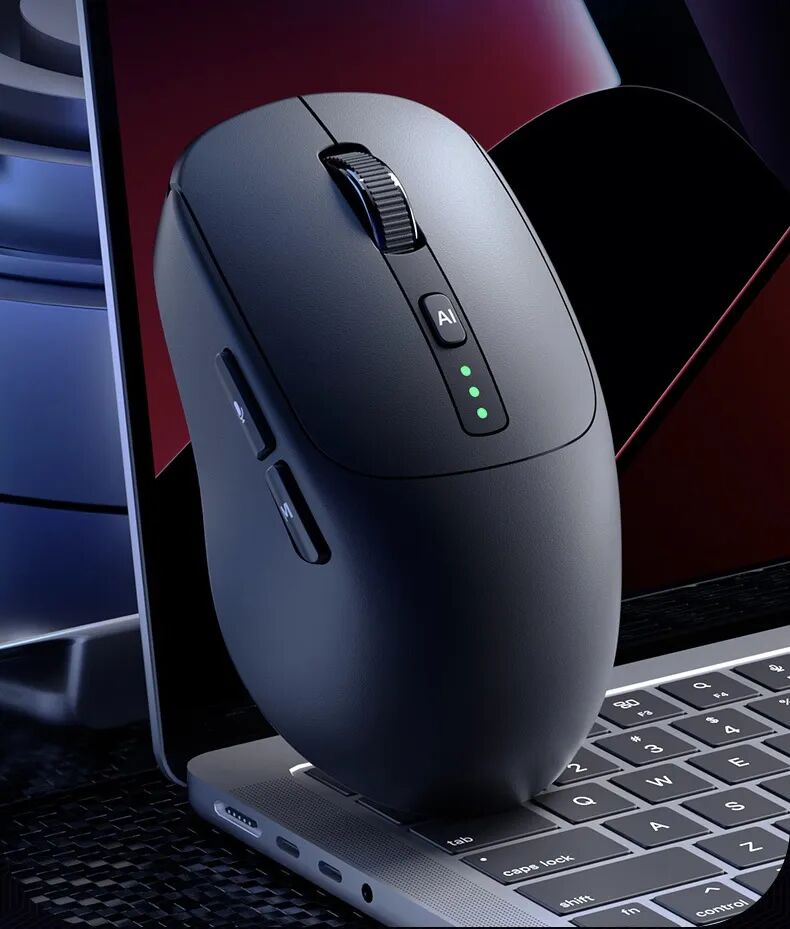Is the AI Mouse a Levy on Intelligence?
![]() 10/13 2025
10/13 2025
![]() 423
423
Two weeks ago, I purchased an AI mouse.
My motivation was straightforward: I wanted to delve into various AI hardware devices and also had a need for voice input functionality. After using it, I've found that with reasonable expectations, the experience is quite satisfactory.

Layout by: Yanzi
"Superpowers" at Your Fingertips: The Core Functions of the AI Mouse
If a traditional mouse is an extension of the hand, then an AI mouse is akin to an "external brain assistant." It integrates robust AI capabilities into this compact device, offering us a range of convenient functions that can be likened to "superpowers."
1. The Revolution of Voice Interaction: Making Input and Communication "Hands-Free"
This is the most fundamental yet remarkable feature of the AI mouse. Through a dedicated AI button, it revolutionizes our interaction with computers.
- Efficient Voice Typing: The AI mouse can transcribe your speech into text in real-time at speeds up to 400 words per minute, with an accuracy rate exceeding 98%. It can even recognize multiple dialects and professional jargon. Whether you're taking meeting notes, organizing interview recordings, or engaging in content creation, it serves as a "keyboard terminator," freeing you from tedious typing.
- Seamless Cross-Language Communication: Language barriers can be frustrating when reading foreign literature or communicating with international friends. The AI mouse supports real-time voice translation and word-by-word translation functions. Simply hold down the button and speak, and it will translate in real-time into the target language. Alternatively, when browsing web pages or documents, a quick swipe will instantly display accurate translation results, making cross-language work and study smoother than ever.

2. The "Wisdom Brain" of AI Large Models: Your Personal Creative and Q&A Consultant
Leveraging built-in AI large models (such as iFLYTEK Spark and ERNIE Bot), the AI mouse transforms into an always-available "wisdom brain."
- One-Click PPT and Copywriting Generation: Simply tell it your topic, such as "Help me generate a PPT on market analysis for AI mice," and it will quickly create a complete outline, content, and basic design for you. Similarly, whether you're writing weekly reports, brainstorming marketing copy, or polishing emails, this "brain at your fingertips" can provide high-quality drafts and inspiration.
- Intelligent Q&A and Instant Search: When encountering questions at work, there's no need to tediously switch windows or open a browser. Simply hold down the AI button and ask directly. Whether it's "What's the weather like today?" or "Explain what 'intelligence quotient tax' means," it can quickly provide answers, becoming the most convenient encyclopedia on your desktop.

3. The "Efficiency Accelerator" for Workflows: Breaking Down Barriers Between Software
Beyond input and creation, the AI mouse can also serve as an intelligent hub to optimize your daily computer operations.
- Voice Command Control: We can control the computer through simple voice commands, such as "Open WeChat" or "Open last week's work report," eliminating the need to search through layers of folders and making operation paths shorter and more direct.
- Screenshot Text Recognition (OCR): When you want to quote text from images or scanned PDFs, this function becomes particularly useful. A quick screenshot allows the text in the image to be rapidly extracted for direct editing and copying, greatly enhancing the efficiency of data processing.

The Gap Between Ideal and Reality: It's Not Perfect
However, there is still a gap between the ideal and reality in actual use.
Firstly, AI-generated content is far from "one-step perfection."
The PPTs it generates may have simplistic layouts and lack design flair; the copywriting it produces may lack depth and emotion, still requiring significant manual optimization and refinement. It functions more as an efficient "first draft assistant" rather than a standalone "creative master."
Secondly, the core voice function is dependent on the usage environment.
It may be a marvelous tool in a quiet, private office, but in noisy open workspaces or public areas, the accuracy of voice recognition may decrease to some extent. Additionally, speaking into the mouse may attract unwanted attention from others, compromising privacy.

Whose Honey, Whose Poison? A Precise User Persona for the AI Mouse
The value of any tool lies in the hands of its users. The AI mouse, like honey to some, may taste bitter to others. It's not suitable for everyone, and a clear user persona can help us determine which side we're on.
It will be "honey" for these people (suitable users):

But if you are:
- Light Office Users: If your daily work involves simple tasks like sending and receiving emails or browsing the web, traditional mice and free software are more than sufficient. The powerful functions of the AI mouse are likely to go unused, becoming another "dust-collecting" product in your drawer.
- Those with Unrealistic Expectations: Users who expect AI to generate perfect PPTs or write stunning copy with a single click are destined for disappointment. AI currently serves as an auxiliary role. If you lack the patience for secondary creation and optimization, it will only leave you feeling "not intelligent enough." However, to effectively utilize all AI tools, humans must remain the primary actors, with AI serving only as an assistant.

Is the AI Mouse an Intelligence Quotient Tax?
When we discuss whether the AI mouse is an "intelligence quotient tax," we are essentially exploring whether its "value" matches its "price." However, value is a relative concept that varies from person to person. Simply defining it with a single label is overly simplistic.
Firstly, we must recognize the fine line between "tax" and "investment."
For someone who rarely uses its core functions, spending hundreds of yuan on an AI mouse is undoubtedly an unwise "intelligence quotient tax." However, for a professional who can save an hour of work time each day through its use, this expenditure becomes a highly rewarding "efficiency investment." Here, time costs are directly converted into monetary value, making the calculation potentially quite favorable.
Secondly, we often overlook the implicit value of paying for "convenience" and "integration."
Many functions of the AI mouse can be cobbled together using free software. However, for many people, firstly, they may not be able to find so many free software options; secondly, the time cost involved is significant; and thirdly, even if found, the cost of switching attention and the fragmented operational experience greatly detract from the overall user experience.
The core advantage of the AI mouse lies in seamlessly integrating these dispersed functions into hardware and providing the shortest interaction path with "one-click activation." This is akin to our willingness to pay for more convenient ride-hailing apps instead of struggling to navigate complex bus routes. Paying for a smooth, uninterrupted "immersive" work experience is itself a reasonable consumer choice. Therefore, the determination of whether it's an "intelligence quotient tax" depends on your valuation of "convenience."

It's Not Just a Mouse; It's a Gateway to the Future
So, is the AI mouse an "intelligence quotient tax"? The answer is not black and white. Its value highly depends on your actual needs and workflow. For those who can effectively utilize it, it's a powerful tool for enhancing productivity; for those whose needs don't align, it may become an expensive ornament.
More importantly, we should look beyond the immediate horizon. The emergence of the AI mouse signifies more than just a hardware upgrade; it's like a trailblazer for the "AI PC" era, heralding a new paradigm for future human-computer interaction—a time when deep collaboration with machines can be achieved through natural language.
Today's AI mouse may not be perfect, but it represents the inevitable trend of combining AI with hardware. Instead of dwelling on the current debate of "tax" versus "investment," we should start thinking about how to embrace this wave, arm ourselves with new tools, and become masters of AI rather than being left behind by the times. After all, tickets to the future often seem a bit expensive at first.
Would you like to experience the AI mouse?









